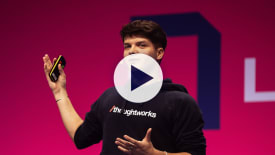
Latest
-

Why AI economics are fundamentally broken
Making money from software is not the same equation in the AI era.
-
If 95% of generative AI pilots fail, what’s going wrong?
Learning the right lessons from that MIT study
-
“Trial by fire” is destroying your incident response
The worst time to learn about observability is during an outage.
-
 In partnership with Harness
In partnership with HarnessHow AI is increasing systems resiliency
Facing more code than ever, learn the resiliency best practices used by SREs, including where AI can help
Editor’s picks

Deadline: January 4, 2026
Call for Proposals for London 2026 is open!
Essential reading

How to build an effective technical strategy
Building a tech strategy requires a lot of moving parts. Learn about what routes to take and whether decisions should be top-down.
On our Technical Direction playlist

Modernizing legacy systems: A technical strategy for evolving monoliths into modern architectures at HelloFresh
Gain insights into transforming legacy systems into scalable architectures, with practical strategies for balancing stability, managing technical debt, and enabling growth opportunities at HelloFresh.

Technical Vision vs. Technical Strategy: The difference and why it matters
Jonathan Maltz digs into the nuts and bolts of setting a successful technical strategy. Startin by talking about the difference between technical vision and technical strategy.

How to implement platform engineering at scale
In this webinar, we’ll hear from enterprise engineering leaders who’ve overcome cultural barriers and team silos, and successfully adopted platform engineering practices in their orgs.

Good technical debt
Jon Thornton discusses how this framework was used to rapidly build and ship Squarespace’s Email Campaigns product in less than 15 months. Along the way, you’ll get several practical guidelines for how tech debt can supercharge your technical investments.

Creating, defining, and refining an effective tech strategy
Having a defined tech strategy creates alignment and keeps everyone on the same page. So how can you ensure yours is most effective? Panelists Anna Shipman, Randy Shoup, Papanii Nene Okai, Nimisha Asthagiri and Anand Mariappan share their tips.
More about Technical Direction
-
12 things to consider when assessing open source software
Open source has been gathering more and more traction. But consider some of the risks before taking a leap.
-
Leading open-source teams in large organizations
You can nurture and grow a highly impactful open-source project in your organization by systematically building an excellent team, technology, and product.
-
Whatever happened to Big Data?
In the world of AI, cloud services, and automation, the tools and expertise engineering managers need to mine large-scale data sets are changing, fast.
-
What you need to know about Biden’s AI executive order
US President Joe Biden has announced a sweeping executive order covering artificial intelligence. Here’s everything you need to know about how the US government is looking to regulate the technology.
-
How OpenAI fought off security threats and GPU shortages to scale ChatGPT
The rapid rise of ChatGPT exposed OpenAI to a myriad of scaling issues and security threats, leading to some unique mitigation approaches.
-
Balancing build vs buy decisions in a post-boom world
The question of whether to build software in-house or rely on third-party vendors is more fraught than ever, as budgets come under scrutiny and internal teams get stretched after waves of layoffs.
-
Building a cloud architecture that can scale to any challenge
By building a cloud architecture that could meet the complex needs of international expansion, Nubank has established a more robust and flexible cloud infrastructure.
-
OpenAI explains how they scaled ChatGPT
Ahead of his talk at LeadDev West Coast in October, OpenAI’s Evan Morikawa goes behind-the-scenes on the challenges they faced scaling ChatGPT, the constant need to reset as a leader, and how GPUs don’t in fact grow on trees.
Top Technical Direction videos
-

Ice, confusion, and the 38,000ft crash
Uncover the critical lessons from AF 447’s final moments – how small factors spiraled into disaster and what it teaches us about building resilient systems.
-

Launching a Gen AI powered travel companion: A case for tiger teams
Explore Booking.com’s journey in launching a Gen AI travel companion in 3 months, powered by a tiger team approach for rapid, focused product development and innovation.
-

What your browser can teach you about software security
Explore how browsers securely handle untrusted code and uncover valuable lessons for designing robust systems from a security engineer’s perspective.
-

Tackling tech debt
Learn practical strategies from a seasoned CTO on managing tech debt effectively – when to embrace it, how to prioritize it, and turning it into growth.
-

Exploring the (testing) pyramid – An expedition towards more accessibility
Explore how applying the testing pyramid to accessibility can streamline development. Learn methods to lower costs, speed feedback, and enhance both product quality and inclusivity.
-

Tech odyssey: The epic saga of a mega migration to temporal
Embark on a journey through the challenges and triumphs of a major tech migration, revealing strategies for scaling, continuous development, and operational excellence in platform transformation.
-

Scaling your ML platform to enable the industrialisation of AI and ML development
Delve into the essentials of scaling ML platforms to industrialize AI development, with insights on prioritizing tools and requirements for efficient, large-scale model deployment.
-

From hurdles to highways: Crafting a collaborative experimentation ecosystem at GetYourGuide
Discover how GetYourGuide transformed its experimentation platform, navigating challenges to build a streamlined, collaborative, and innovative ecosystem for efficient testing and creativity.

